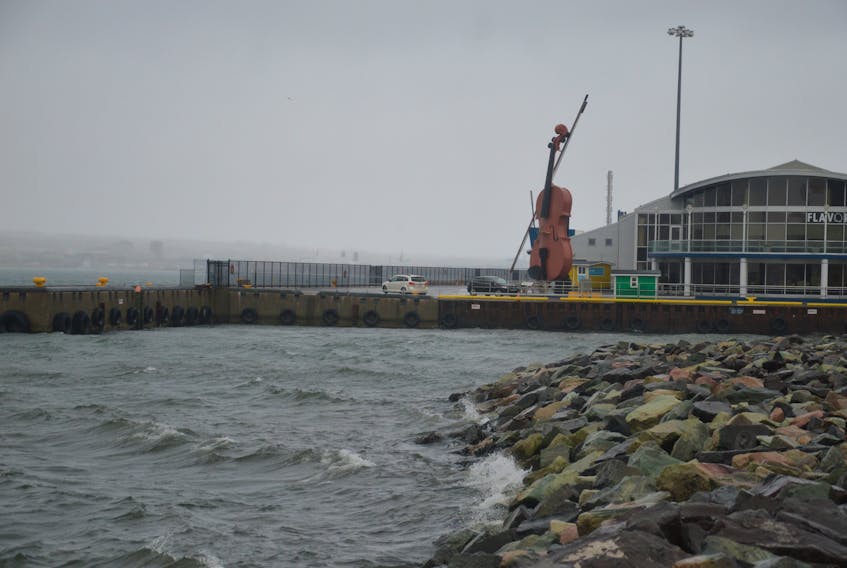I heard the bang-bang-bang of hammering in the background when I called Kevin Camus on the phone Wednesday.
But that wasn’t because the Cheticamp carpenter was battening down the hatches ahead of the big blast of wind heading his way.
By that point, SaltWire’s chief meteorologist Cindy Day had forecast that Cape Breton’s west coast could experience gusts of 140 km/h Thursday, as the latest of the region’s fabled Les Suêtes winds came barrelling down over the Cape Breton highlands.
“We get six in the 140-180-km/h-range a year,” Camus, the owner of KJC Home Renovations Ltd. said, in an unimpressed tone. “For some it’s a big deal. Not for the people of Cheticamp.”
Day, in fact, experienced her first Suêtes winds on a trip to Inverness County last year. It was what would be considered a moderate example of the phenomenon, in the 90-120-km/h-range, but still “felt like the roof was going to come off of the motel,” she said.
The Suêtes, she told me, tend to be more common from late fall to early spring because of the storm systems that can arise that time of year. But they can happen any time the right conditions exist to send swirling air molecules up the eastern slope of the highlands, then, in a steep descent, down the other.
Day explained that these are katabatic — Greek for descending — winds. They occur as far away as France, where they are known as Mistrals, and as near as southwestern Newfoundland, where the Wreckhouse winds come howling like hurricanes out of the Long Range Mountains.
Wherever they happen these winds are the stuff of legend. Once, years ago, I drove to Grand Étang, not far from Cheticamp, to interview an older gentleman who lived there in a farm atop the crest of a hill. He told me that after a particularly bad blow, he emerged from his house to discover that his 1,137-litre gasoline tank had just disappeared, presumably blown into the Atlantic Ocean which was just down the hill.
Another time, with the winds topping an estimated 200 km/h, he was reduced to crawling along the ground trying to reach his barn. When a gust hit, he grabbed for a gatepost, a prudent move since the wind lifted him off the ground.
About a year ago, another Suêtes toppled a transport truck in the vicinity of Saint Joseph du Moine. Two years before that, winds of 200 km/h blew a wind turbine apart in a field near Grand Etang.
But the highest winds Camus has known came on March 13,1993, officially clocking in at 233 km/h, which was powerful enough to tear part of the roof off Cheticamp’s Sacred Heart Hospital.
He was working search and rescue in those days. When the call came in from the hospital, he climbed into his vehicle. “It felt like I wasn’t going anywhere,” he remembers of his aborted attempt to drive to the disaster site.
Stories like that sound like tall tales. But there’s no denying the accommodations that those who live on the stretch of Cape Breton between Margaree Harbour and Bay St. Lawrence make to live in a place where, at any moment, a wind can descend, flattening telephone poles, trashing homes and fishing boats and once, I was told, driving gravel into the interior walls of the local barber shop.
Camus, who has been building homes in the area for two decades, told me that some of the newer homes are made out of cement, but the wooden ones are built from thicker plywood rather than cheaper chip-board, and with extra bracing than they would have if erected elsewhere.
Roofs in the area are steeply sloped and include metal hurricane drip edges to help shingles resist wind, along with mechanical fastenings to better keep things intact. When Camus is putting on a roof he goes the distance, spreading extra tar along the special asphalt shingles, and then using a heater to bake them on.
“Then,” he says, “its hope for the best.”
Here’s one way of knowing you are in Cheticamp: the doors open outward rather than inward, since that makes them better able to withstand the area’s hurricane-force winds.
There are other ways, too. Yards are clean and empty, since anything left lying around becomes a missile when picked up by a 200-km/h wind. Every house has a generator, since the power goes out there more often than virtually anywhere else in the province.
And, of course, when Environment Canada sends out a special Les Suêtes wind warning, as it did Wednesday, the people of Inverness County take notice. Even if, like Camus, they’re pretty used to it by now.









